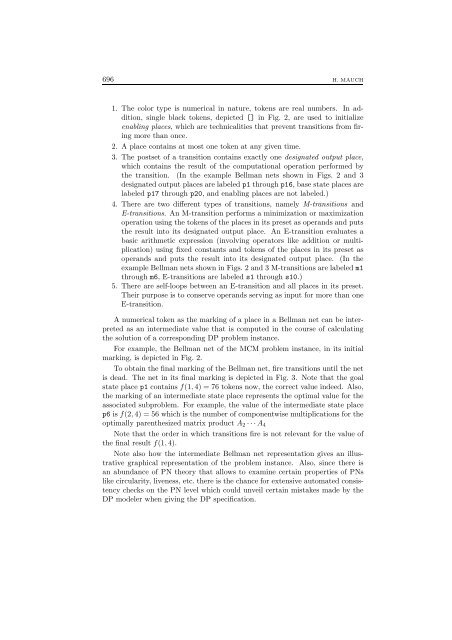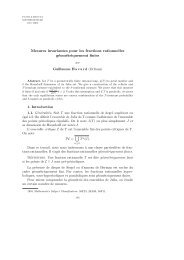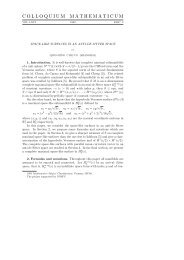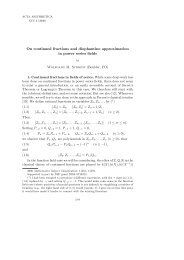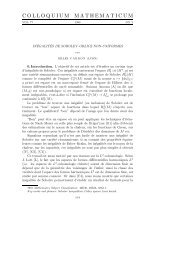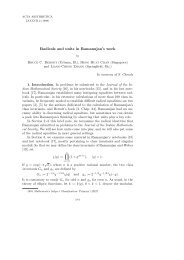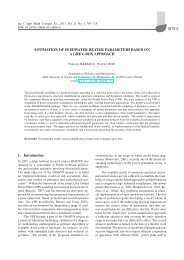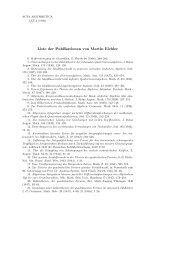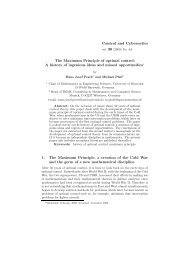DP2PN2Solver: A flexible dynamic programming solver software tool
DP2PN2Solver: A flexible dynamic programming solver software tool
DP2PN2Solver: A flexible dynamic programming solver software tool
Create successful ePaper yourself
Turn your PDF publications into a flip-book with our unique Google optimized e-Paper software.
696 H. MAUCH<br />
1. The color type is numerical in nature, tokens are real numbers. In addition,<br />
single black tokens, depicted [] in Fig. 2, are used to initialize<br />
enabling places, which are technicalities that prevent transitions from firing<br />
more than once.<br />
2. A place contains at most one token at any given time.<br />
3. The postset of a transition contains exactly one designated output place,<br />
which contains the result of the computational operation performed by<br />
the transition. (In the example Bellman nets shown in Figs. 2 and 3<br />
designated output places are labeled p1 throughp16, base state places are<br />
labeled p17 through p20, and enabling places are not labeled.)<br />
4. There are two different types of transitions, namely M-transitions and<br />
E-transitions. An M-transition performs a minimization or maximization<br />
operation using the tokens of the places in its preset as operands and puts<br />
the result into its designated output place. An E-transition evaluates a<br />
basic arithmetic expression (involving operators like addition or multiplication)<br />
using fixed constants and tokens of the places in its preset as<br />
operands and puts the result into its designated output place. (In the<br />
example Bellman nets shown in Figs. 2 and 3 M-transitions are labeled m1<br />
through m6, E-transitions are labeled s1 through s10.)<br />
5. There are self-loops between an E-transition and all places in its preset.<br />
Their purpose is to conserve operands serving as input for more than one<br />
E-transition.<br />
A numerical token as the marking of a place in a Bellman net can be interpreted<br />
as an intermediate value that is computed in the course of calculating<br />
the solution of a corresponding DP problem instance.<br />
For example, the Bellman net of the MCM problem instance, in its initial<br />
marking, is depicted in Fig. 2.<br />
To obtain the final marking of the Bellman net, fire transitions until the net<br />
is dead. The net in its final marking is depicted in Fig. 3. Note that the goal<br />
state place p1 contains f(1, 4) = 76 tokens now, the correct value indeed. Also,<br />
the marking of an intermediate state place represents the optimal value for the<br />
associated subproblem. For example, the value of the intermediate state place<br />
p6 is f(2, 4) = 56 which is the number of componentwise multiplications for the<br />
optimally parenthesized matrix product A2 · · · A4<br />
Note that the order in which transitions fire is not relevant for the value of<br />
the final result f(1, 4).<br />
Note also how the intermediate Bellman net representation gives an illustrative<br />
graphical representation of the problem instance. Also, since there is<br />
an abundance of PN theory that allows to examine certain properties of PNs<br />
like circularity, liveness, etc. there is the chance for extensive automated consistency<br />
checks on the PN level which could unveil certain mistakes made by the<br />
DP modeler when giving the DP specification.


